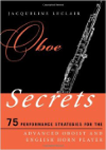 Oboe Secrets: 75 Performance Strategies for the Advanced Oboist and English Horn Player by Jacqueline Leclair
Oboe Secrets: 75 Performance Strategies for the Advanced Oboist and English Horn Player by Jacqueline Leclair
(New York: Scarecrow Press, 2013). ISBN-13: 978-0810886209
Jacqueline Leclair’s book Oboe Secrets is part of Scarecrow Press’s series “Music Secrets for the Advanced Musician,” designed as a set of best practices for more advanced performers and composers. Her book is intended as a resource for those who have moved well beyond the beginner or intermediate level, an area in which there are few publications. Additionally, in the Preface, Leclair specifically targets her book to advanced high school oboists and English hornists, professional performers, teachers, and avid amateur musicians. Her intention is to focus on issues she considers “commonly misunderstood, ignored, or persistently problematic.” She also aims to disseminate suggestions that might be new to her intended audience.
Leclair’s writing is very clear and concise throughout the book. It is easy to read, and in a short space covers many points that would help her readers improve their playing. Whereas she accomplished her goal of addressing issues that are not restricted to the beginner or intermediate levels, I found that many of her 75 strategies extend to areas beyond playing the oboe and English horn, despite her use of examples from these instruments.
Oboe Secrets is organized into 9 chapters. Chapter 1 deals with practice strategies, and most of these ideas would be useful for any performing musician. Much of the material is geared toward wind players and some of it deals with woodwind fingering issues, but the material is more general than specific to the oboe.
Chapter 2 on Tone and Rhythm contains more general material, but here one also sees some very specific oboe techniques such as use of the “pre-tone” and some reed-alone exercises that can improve embouchure. Leclair also discusses vibrato in this chapter, which can be a sensitive subject in the oboe world. She acknowledges this in the disclaimer at the beginning of the opening paragraph of secret #27: “I remember my mother advising me when I was young that, while in polite company, I should avoid conversations about politics, religion, and sex. We should probably add a fourth topic to that list: vibrato.” She argues that a variety of different vibratos are required of an oboist depending on the situation, and her subsequent detailed suggestions include several exercises that explore two kinds of vibrato: one produced in the abdomen, and the other in the throat.
Chapter 3 on reed making (oboe specific) has some very good suggestions that might help relieve the anxiety surrounding making reeds. These sections are especially useful for the intended audience, who, as a group, tend to have the most difficulties with reed making. Leclair goes into great detail about this subject, discussing scraping on the heart, knowing when and how much to clip, determining when to create the back portion of the reed, gouging, consistency and testing.
Chapter 4 on Health and Strength Strategies is where Leclair’s background in the Alexander Technique and yoga comes to the fore. Much of this chapter, like Chapter 1, is more general in nature and would prove informative for any wind player. Chapter 6, “Equipment Strategies,” is primarily about maintaining and adjusting the instrument. Chapter 8 concerns the English horn and how playing it is different from the oboe. Chapter 9 consists of material to help one develop extended techniques that are becoming more common in contemporary music performed by Leclair’s intended reading audience.
Chapter 7, “Sundry Strategies,” contains material not easily grouped with the other chapters. One of the “secrets” in this chapter addresses a problem unique to the oboe, namely giving the tuning “A.” The book’s audience should benefit from Leclair’s suggestions here. For her, the tuning “A” is a solo and everyone expects it to be perfect, thus she provides tips on how to accomplish a perfect “A” in this “secret.” Also covered in this chapter are high-note fingerings, and some general information including rehearsal etiquette, which is, unfortunately, sometimes an issue these days.
While most professional oboists will be familiar with Leclair’s advice, this book would be a great resource for advanced students and amateurs looking for ways to improve their playing. Reading it was a great reminder of all the things I have learned over the years and it will be a valuable resource for my students.


